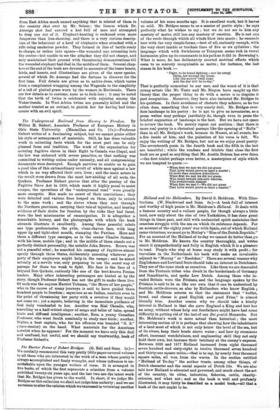The Underground Railroad front Slavery to Freedom. By Wilbur H.
Siebert, Associate Professor of European History in Ohio State University. (Macmillan and Co. 17s.)—Professor Siebert writes of a fascinating subject, but we cannot praise either his style or arrangement of materials. Still, he has done valuable work in collecting facts which for the most part can be only gleaned from oral tradition. The work of the organisation for assisting fugitive slaves in their flight to Canada was illegal, and the law was enforced with severe penalties, so that nothing was committed to writing unless under necessity, and all compromising documents were destroyed. Enough survives to enable us to gain a good idea of this extraordinary revolt of white men against a law which in no way affected their own lives ; and the main actors in the revolt were drawn from the most law-abiding of all sects, the Quakers. Professor Siebert proves that after the passing of the Fugitive Slave Act in 1850, which made it highly penal to assist escapes, the operations of the "underground road" were greatly more energetic. Men made no secret of their convictions ; they were detected and various fines heaped on them, only to return to the same work ; and the slaves whom they sent through the Northern provinces, carrying their tale of injustice, and bearing evidence of their desire for freedom by the risks they had faced, were the best missionaries of emancipation. It is altogether a remarkable history, and the photographs with which the book abounds illustrate it excellently. Among these peaceful rebels one type predominates, the grim, clean-shaven face, with long upper lip and tight-shut mouth, stamping the Puritan. Here and there a different type emerges, as in the orator Charles Sumner, with his loose, mobile lips ; and in the middle of them stands out a perfectly distinct personality, the notable John Brown. Brown was not a peaceful rebel ; he marched his company of fugitives almost openly through three States, deliberately annexing whatever pro- perty of their employers might help in the escape ; and he aimed actually at a servile war, only proposing to use the secret way of passage for those too weak to fight. His face is the face of a brigand Don Quixote, curiously like one of the best-known Fenian leaders. Many other interesting personages are hinted at by the story, though Professor Siebert has not the gift to make them live. Of such was the negress Harriet Tubman, "the Moses of her people," who in the course of many journeys is said to have guided three hundred people to freedom ; sagacious as an Indian, resolute even to the point of threatening her party with a revolver if they would not come on ; yet a mystic, believing in the immediate guidance of God daily vouchsafed to her. Another was Rial Cheadle, who, travelling as a half-witted singer of songs and teller of tales, spread hints and diffused intelligence ; another, Ross, a young Canadian Professor, who went South nominally to study rare birds ; another, Walter, a boat captain, who for his offences was branded "S. S." (slave-stealer) on the hand. What materials for the American novelist when he appears I For the moment we have only this dull and confused, but useful, and we should say trustworthy, book of Professor Siebert's.


















































 Previous page
Previous page